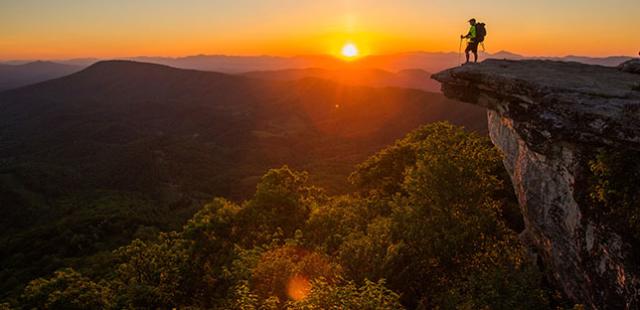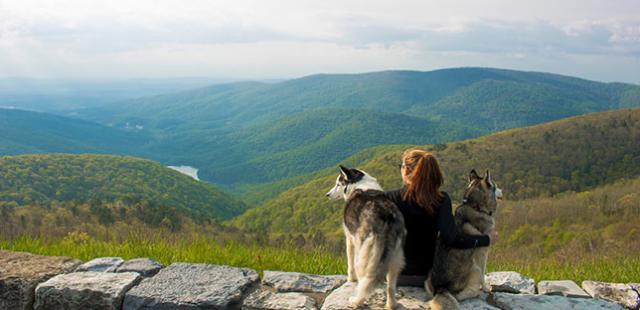George Washington and Jefferson National Forests
Spend some time in Virginia and you will hear the names George Washington National Forest and Jefferson National Forest. But what are they? Where are they? And what can you do there?
Named for two founders of our country, the George Washington National Forest and Jefferson National Forest (GWJNF) were combined in 1995 and are now managed as one unit of the national forest system, with a whopping 1,664,110 acres in Virginia. These massive swaths of land stretch in parcels extending up the spine of the Appalachians roughly from the Tennessee state line following the northwest Virginia boundary with Kentucky and West Virginia. They are also found along the Blue Ridge from Roanoke to Waynesboro, as well a few small parcels in Kentucky and West Virginia.
Virginia’s GWJNF has a myriad outdoor recreation opportunities – hiking, paddling, bicycling, camping, wildlife viewing, fishing, scenic driving, and more. GWJNF boasts over 2,300 miles of streams, over 40 species of trees, over 60 species of animals and over 50 endangered plant species. It is a land with around 200 recreation sites such as campgrounds and picnic areas.
Over 2,200 miles of trails lace the GWJNF, allowing hikers, bicyclers and equestrians enough pathways for a lifetime. There are 23 federally designated wildernesses within mountainous terrain ranging from 515 feet in elevation near the Shenandoah River all the way up to Virginia’s highest point of 5,729 feet at Mount Rogers.
-
KNOW BEFORE YOU GO
- Entering the GWJNF is generally free. There are no entry gates as such, especially with the huge tracts that comprise the forest. However, specific recreation areas such as Cascade Falls near Pembroke and campgrounds such as Elizabeth Furnace near Strasburg will either require an entrance or user fee.
- Since the GWJNF is so big, it is broken up and managed in districts, with supervision concentrated on higher use areas. Roads course throughout the forest, but are often gravel. However, they do allow access to backwoods areas. Even at that, the vast majority of the forest is untamed game lands left to Virginia’s wild fauna and flora, accessible only by those hitting the trails on foot, bicycle or horse.
- National Forest maps are essential for exploring throughout the forest. Your smart phone might help you get one place at a time, but to truly discover the GWJNF maps are essential. Try National Geographic Trails Illustrated maps. They have 9 individual maps covering various parcels of Virginia’s GWJNF. Pick your area, then purchase your map.
Hiking Trails
With over 2,200 miles of trails to trek, the GWJNF has enough pathways to keep most of us busy for years. The forest contains 325 miles of America’s most renowned path — the Appalachian Trail — more mileage of the AT than another other national forest in the country. Other hiker trails wind through designated wildernesses and scenic areas. Some of them are specially designated national recreation trails.
Here are some sampler hikes to whet your appetite for trail trekking in Virginia’s GWJNF, with one hike in each of the 8 ranger districts.
Elizabeth Furnace
Nearest Town: Strasburg
Distance:.9-mile
What You Need to Know: The short walk is long on interpretive information.
GPS Coordinates: 38.92899, -78.32694
Two interconnected nature trails present a splendid overview of charcoal and iron making in 1800s Virginia, all in a gorgeous setting along Passage Creek, nestled between Massanutten and Green Mountain near Strasburg. And you get to see the iron furnace remains up close, as well as a cabin from the 1830s. Plan on adding picnicking, trout fishing and car camping to your historic hiking agenda – it is all here at Elizabeth Furnace.
Confederate Breastworks Interpretive Trail
Nearest Town: Churchville
Distance: .5-mile
What You Need to Know: The interpretive trail is told through letters of a Georgia Confederate soldier.
GPS Coordinates: 38.310833, -79.38361
This half-mile interpretive path traverses the site of Confederate defenses situated atop Shenandoah Mountain. While you are here, have a meal at the nearby Mountain House Picnic Area.
Back Creek Gorge Trail
Nearest Town: Warm Springs
Distance: 1.3-miles each way
What You Need to Know: The out and back hike ends at the national forest boundary.
GPS Coordinates: 38.069278, -79.883943
This wildflower rich path begins at Blowing Springs Campground and traces an old railroad grade up the Back Creek gorge. Enjoy blue pools divided by shoals on Back Creek. After a half-mile you will reach a low waterfall. Continue upstream on the track in deep woods, passing more cascades and pools before reaching trail’s end and backtracking.
Yaccrs Run Trail
Nearest Town: Clifton Forge
Distance: 3.0-mile loop
What You Need to Know: Bring lunch. The hike starts at Longdale Day Use Area, with picnic tables.
GPS Coordinates: 37.79028, -79.70389
This well marked but oddly named path is good for families and novice hikers. The track shows off stream valleys and ridgetops with views. The biggest challenge may be crossing Blue Suck Run without getting your feet wet. By the time you return to the recreation area your appetite will be whetted to enjoy a trailhead picnic at the historic CCC-developed area.
Crabtree Falls Trail
Nearest Town: Vesuvius
Distance: 2.7-miles
What You Need to Know: The falls can be crowded on nice weekends, especially early summer.
GPS Coordinates: 37.843056, -79.075
Crabtree Falls might be the highest waterfall east of the Mississippi, depending on how you qualify a waterfall, but there is no doubt that Crabtree Falls is the highest waterfall in Virginia. Crabtree Falls is really a name given to five major waterfalls (and several smaller ones) on Crabtree Creek, which flows into the Tye River. Within 0.5 mile, the creek drops 1,200 feet.
Dragon's Tooth Trail
Nearest Town: Salem
Distance: 2.4-miles one-way
What You Need to Know: The final climb to the tip of the Dragons Tooth is for nimble hikers only.
GPS Coordinates: 37.3787, -80.1563
This deservedly popular hike travels up Cove Mountain to a vertical stone slab providing 360-degree panoramas. Along the way, you will ascend a small stream valley then meet the Appalachian Trail. From there, the AT traverses boulder fields and upturned rock slabs that require some scrambling. Climb the Dragons Tooth for unrivaled Virginia highland vistas.
Elk Garden
Nearest Town: Konnarock
Distance: 3.8-miles round-trip
What You Need to Know: Views start from the moment you hit the trail.
GPS Coordinates: 36.65859, -81.59455
This high country ramble start at elevated Elk Garden, then joins the AT as it climbs a field with views. Drift in and out of woods, including high elevation spruce-fir forests. Reach Deep Gap. Take a break among the yellow birches. Return via the Virginia Highlands Horse Trail for varied scenery, or backtrack on the AT.
Guest River Gorge
Nearest Town: Norton
Distance: Up to 5.9 miles one-way
What You Need to Know: Hike as far or short as you please on this lesser visited rail trail.
GPS Coordinates: 36.9238, -82.4517
Hike a railroad grade-turned-trail. First pass through the Swede Tunnel, then cross the Guest River – a Virginia State Scenic River -- on a high bridge. Continue down the cliff and bluff rimmed canyon, viewing giant streamside boulders. Side streams form waterfalls during wet weather.
Camping and Campgrounds
Virginia’s George Washington and Jefferson National Forest is dotted with over 50 campgrounds, overlain on the entire length of the forest from Kentucky to Maryland. Amenities range from primitive tent sites to more developed campgrounds with electricity and hot showers. Here’s a sampling of the camping possibilities to be found within the GWJNF.
Elizabeth Furnace
Elevation 790 feet
This small, shady and scenic campground is a favorite of mine. Lots of sites are situated on Passage Creek. The sites offer good privacy, set in the woods, yet convenient to civilization. Hot showers and flush toilets are available during the warm season. There’s lots to do here – water play and fish on Passage Creek, visit historic Elizabeth Furnace, hike or mountain bike trails climbing both sides of the mountains above Passage Creek.
Recreation Opportunities: swim, fish, hike, historic study
Todd Lake
Elevation 1850 feet
Todd Lake is fine developed recreation area with not only a quiet campground but also hot showers and nearby activities. A hiking trail circles the 7.5-acre lake, open to paddling or electric motors only. The big drawing card here is the swim beach. The 20 campsites are first come, first served.
Recreation Opportunities: swimming, hiking, paddling
Blowing Springs
Elevation 1,800 feet
The 22-site campground is centered on a springs emerging from a cave-like opening that pushes out constant 58 degree air, hence the name. Back Creek flows by, adding another water feature in the out-of-the-way getaway. Back Creek Gorge is just a walk away, and is attractive for fishermen.
Recreation Opportunities: hiking, fishing, water play
Morris Hill
Elevation 1,600 feet
The ridgetop campground overlooks gorgeous Lake Moomaw. Has hot showers and flush toilets. Swimming, fishing and boating on Lake Moomaw are just down the hill. Campsites can be reserved.
Recreation Opportunities: boating, paddling, swimming, hiking, nature study
North Creek
Elevation 1,150 feet
North Creek Campground is a small, intimate streamside camp with big sites. Its first come, first served, but has water, no showers. Enjoy the creek or head up to the nearby Blue Ridge Parkway for highland fun.
Recreation Opportunities: scenic driving, fishing, swimming, hiking
The Pines
Elevation 2,100 feet
Set in the Barbours Creek valley, this secluded but free campsite sits in oaks, hickories and pines under tall ridges. The well space sites are seldom full, and an old-fashioned pump well serves the quiet, camp. Fishing Barbours Creek, and hiking Barbours Creek Wilderness are immediate. The Fenwick Mines wetlands and paddling Craig Creek are close by.
Recreation Opportunities: wilderness hiking, fishing, wildlife viewing, paddling
Hurricane
Elevation 2,800 feet
Located in the naturally attractive flat at the confluence of Comers Creek and Hurricane Branch, Hurricane Campground was improved, yet has only 27 campsites and thus cannot get that “campground city” aura so often felt in bigger camping grounds. Yet is does have hot showers and flush toilets.
Recreation Opportunities: Bicycling, hiking, fishing
High Knob
Elevation 3,450 feet
Situated in the shadow of its namesake, small, intimate High Knob Recreation Area offers a historic CCC constructed camp area that does includes hot showers. Hike to the restored High Knob observation tower, visit the small lake here to fish or swim or trek along the Chief Benge Trail.
Recreation Opportunities: hiking, picnicking, swimming, fishing
More Activities
Virginia’s GWJNF has a myriad outdoor recreation opportunities – hiking, paddling, bicycling, camping, wildlife viewing, fishing, scenic driving, and more. GWJNF boasts over 2,300 miles of streams, over 40 species of trees, over 60 species of animals and over 50 endangered plant species. It is a land with around 200 recreation sites such as campgrounds and picnic areas.
Fishing
The GWJNF’s 2,200 miles of streams provide a lifetime’s worth of opportunities for trout and smallmouth bass fishing in a variety of situations, including easily accessible roadside streams, wilderness waterways. Additionally, over 20 ponds and lakes on the forests add boat fishing possibilities for mostly warm water species.
Mountain Biking
Over 1,000 miles of trails are open to mountain bikers. Bicyclers can also ply any forest roads. Mountain bikers have their favorite areas, such as Pandapas Pond trails near Blacksburg and the Iron Mountain trail network near Damascus. The detailed National Geographic Trails Illustrated maps show all paths open to mountain bikers. Casual bicyclists will seek out rail trails such as the Virginia Creeper Trail or paved campground roads at places like Sherando Lake Campground or Beartree Campground.
Paddling
Most paddling streams on the GWJNF are steep and seasonal or otherwise only partly on national forest land, though the South Fork Shenandoah River is a good destination, as is North Fork Pound River. However, national forest ponds and lakes provide excellent flatwater paddling, namely Lake Moomaw and Bark Camp Lake.










